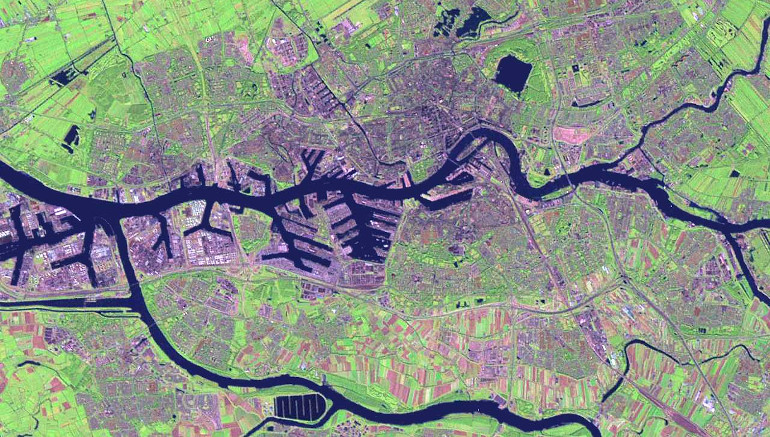Jess Spear is a member of Socialist Alternative in the US.
Human beings have radically altered the Earth, adapting nature in the struggle to survive and thrive. The pace of change accelerated rapidly with the development of agriculture and class-based society. It hit breakneck speed in the industrial revolution, and with post-war scientific and technological breakthroughs. Many now say that we have entered a distinctive geological epoch – a new human era, the Anthropocene.
Humans, arriving on the scene roughly a million years ago, and building modern industrial society as we know it only about 50 years ago, represent a blip in Earth’s 4.5 billion year history. Yet, at each stage of humanity’s development, we have modified nature and therefore modified our own evolution, setting the course for biological and social changes. From simple farming to unearthing and burning fossil fuels, to unleashing atomic bombs, our interaction with nature has gone from local to global. Humankind has, without a doubt, left our mark on the planet.
We can discover what the Earth looked like, the shape and position of the continents as they have drifted apart and recombined every 300-500 million years, what creatures roamed its seas and land, and what plants covered the surface, by deciphering the chemical or physical imprints of their existence left behind. And what we’ve learned is that the planet is never static. The planet – as we know it, the Earth system comprised of rock, water and atmosphere in constant interconnected cycles of energy exchange – has always had upheaval, mass extinctions, and climate change. Earth’s history is full of radical change.
Nonetheless, scientists today are ringing the alarm bells over the rate of change we’re witnessing compared to that which existed prior to human society. Climate scientists are pointing to the rapid shift in greenhouse gases, biologists to the rising number of species extinctions, oceanographers to the increasing acidity of the ocean, and soil scientists to the depletion of nutrients and degradation of farmland, as evidence that humanity’s productive activity is overwhelming the Earth system. The rate of increase in carbon dioxide (CO2) is unlike anything they’ve seen in Earth’s history for at least the past 800,000 years.
Climate change and economic depression, the dual crises of capitalism, have produced a growing global revolt and a search for ideas and strategy to end our misery and protect future generations. Mass movements against austerity demonstrate that working people refuse to accept a system that demands severe cuts to living standards to satisfy the 1%. Not yet clear to the vast majority of people rebelling against the ruling elite is with what to replace this rotten system or how. With the window of opportunity to mitigate the consequences of climate change and prevent further disruption inching closer with each passing year, winning the working class to a socialist alternative is ever more paramount. Only scientific socialism can arm the working class with a program and strategy to unite and fight to end the rule of the 1%, transfer power to the 99%, and rapidly implement a plan to develop society along sustainable lines.
More Heat, More Problems
We live relatively brief lives. With only a little less than a century for our point of reference, our perspective on global changes is correspondingly narrow. To add further obfuscation, the Earth is rather large, so we don’t notice the accumulated effects of deforestation, glacier retreat, and massive piles of trash collecting in the Pacific and Atlantic ocean gyres. The Earth’s temperature rising nearly a degree Celsius has virtually no meaning to communities who daily experience larger fluctuations.
That we have unearthed and burned so much carbon, chemically changing the very air we breathe, that there are now 400 molecules of CO2 for every million air molecules – a level not seen in, perhaps, the last 25 million years – up from about 280, is generally unnoticeable. Yet, regardless of our inability to perceive the radical transformation of our atmosphere and the general out-of-sight-out-of-mind privilege most in the developed countries have when it comes to environmental destruction and pollution, we are nonetheless reaching dangerous tipping points.
The consequences of burning fossil fuels have long been known. As early as 1896, Svante Arrhenius published a paper detailing how CO2 absorbs light reflected from Earth’s surface, preventing it from escaping the Earth system (that is, the greenhouse effect). In the late 1950s, Charles Keeling began measuring the CO2 concentration in the atmosphere. Within just a few years he made the startling discovery that not only are there are seasonal fluctuations in CO2 related to plants absorbing it, then decomposition returning it to the atmosphere, but that the overall concentration was rapidly rising every year. The Keeling Curve – which continues to grow as measurements are added to a continuous record from 1958 to today – is regarded as the first proof that industrial activity was transforming the atmospheric concentration of greenhouse gases.
Yet, it is the dramatic and speedy depletion in Earth’s ice inventory that is the canary in the coalmine. The news last year that the west Antarctic ice sheet has destabilised and is expected to disintegrate over the coming centuries should have elicited an immediate response from world leaders. The ice sheet holds enough water to raise global sea level by about 3.3 meters! There is no way to prevent its demise. We can only now adapt to the rising seas. Added to this is the news that a section of the Greenland ice sheet, which contains the equivalent of half a meter global sea level rise, is also melting rapidly. Arctic sea ice has dramatically been reduced, as well, and scientists expect the Arctic will be ice free in the summer as early as 2020.
Earth’s glaciers and ice sheets act as a global air conditioner, keeping the planet cooler than it would be otherwise by reflecting sunlight. The loss of Earth’s ice (land-based ice that is) will not only raise sea level, displacing the more than one billion people inhabiting low-lying coastlines. It will also further disrupt climate, acting as a positive feedback reinforcing global warming. As the ice melts, the Earth absorbs more heat, more ice melts, and so on.
Still, for most people, climate change is about hotter summers and extreme weather events. And, we are not just talking about our future – which will undoubtedly get hotter, with more intense weather – but our current state of affairs. 2015 is set to be the hottest year on record. We have now hit the one degree mark (above pre-industrial levels) for average global temperature rise (up from 0.85 degrees). This added heat has produced heatwaves, flash flooding, and deadly weather events that force us to acknowledge that climate disruption is not merely something scientists debate and discuss for future generations. Climate change is our present.
In 2003, an estimated 70,000 people died from the heatwave that gripped Europe. Since the 1960s extreme weather events have more than tripled, killing an estimated 60,000 people from mostly underdeveloped countries. The World Health Organisation estimates that without mitigation efforts we can expect an additional quarter of a million people will be killed by climate change related effects from 2030-50.
For what we can expect our future climate to look and feel like, what’s important to keep in mind is that the sheer scale of the problem that is current global climate change stems from just a tiny increase in global temperature. Just one degree Celsius. Imagine the impacts on us, the environment that sustains us, and the Earth system itself, when the Earth gets another degree warmer. That is what scientists tell us we can expect by the end of the century, if we don’t stop ‘business-as-usual’.
Welcome to the Anthropocene
The alteration of our planet from human activity, from the top of the atmosphere down to the bottom of the ocean, is so extensive that a growing number of scientists who study Earth’s history and system are now hotly debating whether we have entered a new geological epoch, the Anthropocene (anthropo – human, cene – new), or maybe we have been in it for centuries and just didn’t know it.
Proposing a new geological epoch is not merely adding a date and name to the geological time scale, which spans 4.5 billion years from the formation of the solar system to the present day. In fact, the geological time scale itself is not merely a list of dates and names. It’s also a tool – a common measurement scientists use to understand how changes on our planet from its birth until now occurred. The eons, eras and epochs that comprise it are distinguished by rapid shifts on the entire planet. Acceptance of the Anthropocene as a new epoch is therefore a question of whether the impact humanity has made is abrupt, discernible globally, and undeniably different from the previous epoch, the Holocene (and before that, the Pleistocene). In other words, has human activity fundamentally disrupted the Earth system such that it can be seen in the rocks, water, and atmosphere, and future scientists will see it?
Proponents of adding the new epoch to the geological time scale disagree about when, exactly, the Anthropocene began. The three dates currently being debated – 8,000 years ago, the industrial revolution, and 1945 – represent markers along the road to civilization as humanity discovered and applied new ways to modify nature to satisfy our basic needs. Some argue it began roughly 8,000 years ago when humans began clear-cutting forests and rice farming, which altered the atmospheric concentration of greenhouse gases.
Others argue the Anthropocene really started at the beginning of the industrial revolution when widespread use of fossil fuels began disrupting the Earth system, leading to the effects we are witnessing today and will experience in the future. The widespread atomic bomb testing, beginning with the Trinity Test in 1945, is the latest date proposed. It is supported not because atomic bomb testing itself disrupted the Earth system – though we should not forget that scientists warned of the dangers of a nuclear-war-induced ‘atomic winter’ – but because atom bombs leave a global fingerprint easily seen and measured, and atom bomb testing marks the rise of American capitalism’s unprecedented period of expansion.
Unlike previous changes to the geological time scale, however, the proposals have political and social implications. That scientists are suggesting a new epoch marked by human-caused alterations has correctly been seized by many environmentalists as concrete proof that we are indeed radically altering the planet.
The response from the left has been a mixture of confusion and conflation of the scientific debate and the predictable political response. Some anti-capitalists call foul over the name of the epoch. They argue that its focus on humans, and therefore insinuating all humans are responsible, hides the real root of the rapid changes taking place: namely, capitalism. To others, particularly deep green ecologists, it is proof that humanity is largely sociopathic – how dare we name an epoch after humans! – and that really civilization is the problem, not humans.
These arguments stem from either a misunderstanding or a lack of understanding of how humanity and human society developed over the last million years. A historical materialist analysis of human history and pre-history is in fact the key to unlocking the door to our sustainable future.
Change is Constant
“History can be viewed from two sides: it can be divided into the history of nature and that of man. The two sides, however, are not to be seen as independent entities. As long as man has existed, nature and man have affected each other”, wrote Karl Marx and Friedrich Engels in The German Ideology (1846). Many in the environmental movement, however, believe we can’t interact in nature without causing harm because we, humans, are separate from nature. This argument is embodied in a book written by environmental leader and founder of 350.org, Bill McKibben, The End of Nature (1989).
Similar to Rachel Carson’s Silent Spring (1962), McKibben’s book is seen as one of the first to warn humanity of the dangers of global warming. In it McKibben doesn’t just warn about carbon pollution, he passionately argues that humanity has destroyed nature, that “we have ended the thing that has, at least in modern times, defined nature for us – its separation from human society”. We have altered the chemistry of the atmosphere, he argues, therefore there is no place on Earth one could travel that is untouched by humanity.
Yet, our ‘separation from nature’ is a recent phenomenon, a product of capitalism, which combined wage labour with social production for private profit, separating humans from the Earth on which they laboured for sustenance. For the vast majority of human existence we were intimately connected to the Earth, learned and accumulated knowledge of its seasonal changes, and experienced it as part of our existence, even though we lacked understanding of its driving forces. As Marx explained, “man lives from nature, ie, nature is his body, and he must maintain a continuing dialogue with it if he is not to die”. So, the conception that we are separate from nature is also recent, and is linked to the development of capitalism.
The notion that it is modern industrial society that’s the problem, and that a return to living directly from the Earth is the solution, is both overly simplistic and ahistorical. It extracts civilization from the history of humanity and measures its impact based on the presumed better situation that existed previous to civilization – for the Earth, but clearly not for humans as we died from all sorts of health issues now treatable and preventable.
Furthermore, it ignores that pre-modern humans also greatly altered the Earth. For as long as we’ve had boats (10,000+ years) and people crossed the seas, at first in search of food, then for imperialist conquest and/or in search of religious freedom, we have unknowingly (and many times knowingly) transported species from one side of the Earth to the other, radically altering ecosystems, causing some species to flourish in new environments and others to go extinct. The proponents of the earliest start date for the Anthropocene would argue the advent of agriculture at the end of the last ice age even altered the chemistry of the atmosphere, evidence that humans were radically changing the planet as early as 8,000 years ago.
Indeed, we are not even the first species to transform the atmosphere. To give an extreme example, around 2.7 billion years ago, cyanobacteria (blue-green algae) appeared, becoming the first organisms to photosynthesize and produce oxygen as a by-product. Before they evolved and started pumping out oxygen, there was practically no oxygen in the atmosphere. Without cyanobacteria we would not exist.
Interaction with nature without altering it is impossible. Living organisms must exchange material with the Earth to live, thereby influencing their environment, affecting their evolution and others. As Richard Levins and Richard
Lewontin write in The Dialectical Biologist (1985), “the environment and the organism codetermine each other”. But if all species impact nature in some way, are we, with our increasing population and extensive industrial activity, relegated to the role of nature’s perpetual destroyer?
Within or Without?
Our ability to understand the impact we are having on the planet, that it will have negative consequences for us both in the short and long term, and the decisions we make to alter the course of history, is what sets us apart from cyanobacteria and other organisms. Labour is not just a source of wealth. It is also what created humanity, conscious thought, conscious planning, and the accumulation of knowledge.
The advent of tools, and with it the co-development of the mind, the social activity of hunting and the creation of language, put us on a path to producing food surpluses, the very basis of class society, civilization and scientific understanding. In short, all of human history can be distilled down to the organisation of labour and technique, and the concurrent changes in culture, society, and our environment.
When capitalism replaced feudalism, it started the long process of drawing ever larger sections of the population away from farms and into factories and cities, and changed our ideas about nature in relation to ourselves. No longer did we see ourselves as part of nature, but separate. For the capitalists, nature became a source of free wealth which, when moulded by human labour, produced enormous profits for them. For the new working class, alienated from nature, the ripping apart of the Earth for raw materials, the dumping of toxins into rivers, and the sooty skies above urban centres, represented an assault on nature, a degradation of once beautiful areas. At each moment, as humanity leapt from the agricultural revolution to the industrial revolution, our ideas about ourselves in relation to nature shifted.
Towards a Socialist Future
“We don’t want merely an amelioration of the present society, but the establishment of a new one”. (Engels, quoted by John Green in A Revolutionary Life, 2008) Capitalism has now outlived its usefulness for humanity. It is destroying the environment, disrupting our climate, and relegating a billion people to the slow death of starvation and malnutrition. No one could argue that a system based on the profit motive will solve a problem on which it depends for existence. Capitalism cannot offer the means to restore ecological balance because it places no value in nature. Yet, to throw all of modern civilization, fostered by the tremendous wealth, technology, and resources developed by capitalism, into the dustbin, as some suggest we do, because it also produced environmental destruction, is to ignore the potential, also created by this system, to create a sustainable future.
When capitalism triumphed over feudalism, it unshackled science from the confines of religion which sought to stifle discoveries that challenged its rule. Further development of capitalist technique, socialised production, division of labour, and machinery, required major leaps in science. And though investment in scientific research is primarily focused on how to further maximise profits, the ruling class today also cannot hold back discoveries that ultimately undermine its authority. Whether it is plastic made from banana peels or solar roadways, science applied to environmental and social problems is eroding the authority of those who say fossil fuels are necessary.
Capitalism also developed the force which has the power to liberate all of humanity: the working class. As capitalism forced people off the land and into mainly urban wage labour, it created the force which has the common interest and potential to overthrow it and create a society that benefits the majority. All around you see working people rising up and demanding change because, not only does capitalism hold back the transition to renewable energy, it refuses to invest in society.
The quest for profits has every major corporation and smaller businesses seeking to compete for a market share, depressing wages, cutting benefits, and threatening economic ruin for tax cuts. No longer is capitalism able to grow enough reserves to offer the working class a share of the profits. The ruling elite globally have no idea how to both restore economic growth and ensure payment to the major bondholders of sovereign debt.
Anti-austerity movements from Ireland to Spain to the heroic working class in Greece have refused to accept their fate. Protests against new trade deals – the Trans-Pacific Partnership and the Transatlantic Trade and Investment Partnership – reveal that working people understand that corporations are looking to cement their rule into international law, ignoring the needs of people and the planet.
Overcoming a system that is based on the exploitation of us all, that separated us from nature, and is driving us towards a completely unsustainable future, starts first and foremost with a rejection of its ideas. If we limit what humanity is, ignore what it was and, importantly, do not understand how it changed from one to the other, then we are effectively rejecting the idea that we have evolved and, crucially, that we are still in the process of evolving.
The state of the planet during the Anthropocene, whether we accept the earliest start date or the latest, is that of constant change. Our evolution from hunter/gatherers to modern industrial society involved constant interaction with our environment. It shaped us. We shaped it. Through this process we developed ideas about what we are, what our environment is, and our relation to each other. Humanity, with all the accumulated knowledge and experience of past generations, has over this time also developed the capacity to finally move beyond merely surviving to actually living.
The vast resources, technology, wealth, and human ingenuity could be harnessed and directed to ending the needless suffering, raising living standards globally, and achieving ecological balance. If we grasp this fact and use it to inform our actions, then we can take control over the changes taking place today and which will occur in the future. This vision has the potential to unite the working class in its historical task of overthrowing capitalism. We are at a precipice from which we can choose to either leap off, hoping that capitalism will find a way to profit from building us a safety net, or we can appropriate the tools, technology and resources to build a bridge to a socialist future.




